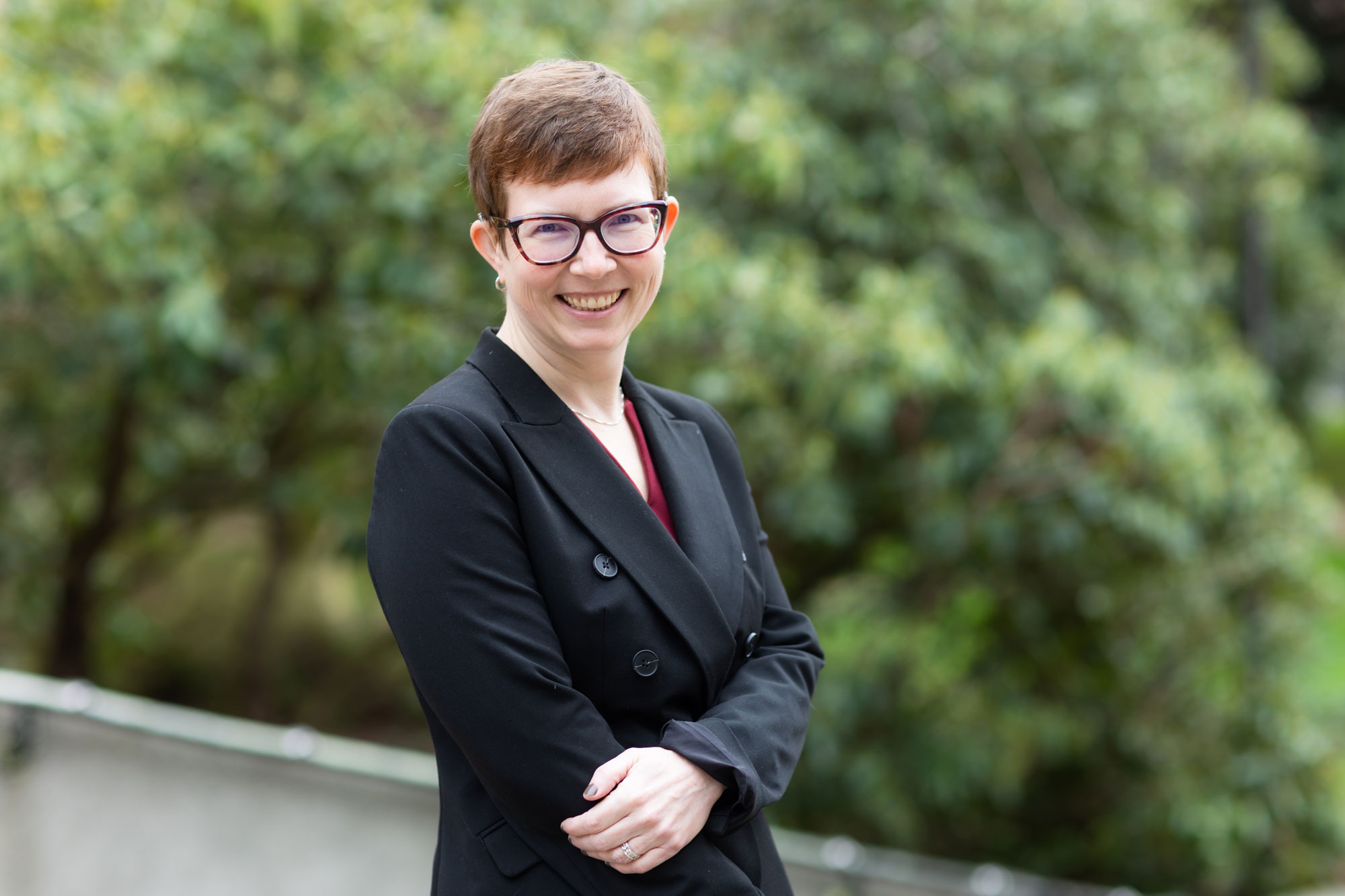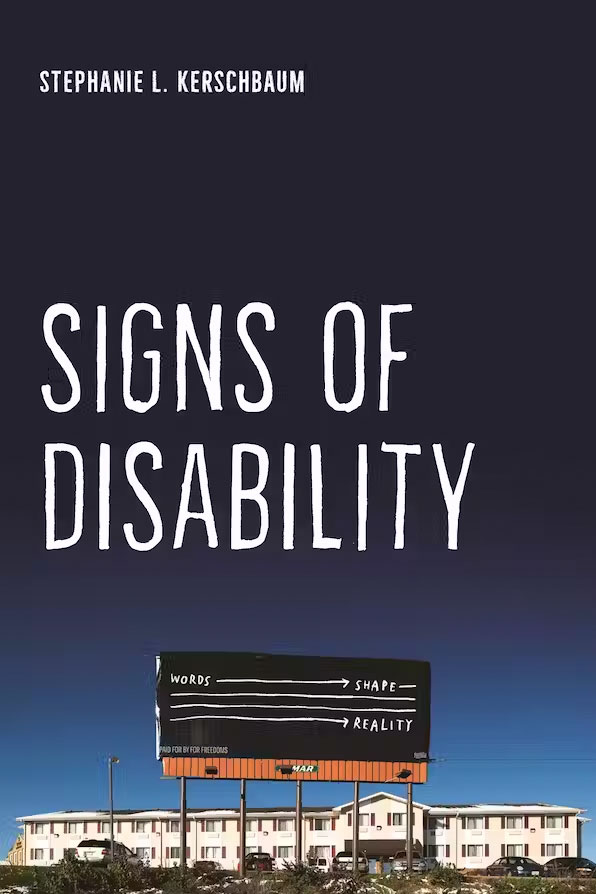
Signs of disability Signs of disability Signs of disability
Stephanie Kerschbaum explores how we notice (and sometimes don't notice) disability.
By Caitlin Klask | Photo by Danielle Barnum | Viewpoint Magazine
When I scheduled an interview with Stephanie Kerschbaum, an associate professor of English who is deaf, I made a mistake. I wrongly assumed she was tired of being asked about accommodations for her disability. I proceeded as I would with any other professor, asking her to meet me in-person.
But Kerschbaum isn’t just any other professor; for one thing, she specializes in rhetoric and recognizes the complexity of conversation. “No form of communication is natural,” she says. “They’re always sort of created and negotiated.” She graciously accommodated our visit by bringing a sign language interpreter.
Speaking of negotiated conversation, interviewing someone can be awkward, in that one person generally asks questions and the other person has all the answers. And at the time of our interview, Kerschbaum—whose second book, “Signs of Disability,” had recently been published by NYU Press—was tired of having all the answers. She references Annika Konrad’s concept of “access fatigue.”
“She built this concept out of interviewing blind and low-vision people about their experiences,” Kerschbaum says. “They talked about how they might just choose not to do things or not to go places because they just didn’t feel like having one more interaction [about accessibility].”
I asked Kerschbaum for reading recommendations. She offered Sami Shalk’s “Black Disability Politics,” which shows how Black activism and disability justice have been intertwined for at least 50 years. And “Academic Ableism,” which tackles structural inequities in colleges and universities and the benefits of inclusive education for all students. And of course, her own books.
 Her co-edited collection, “Negotiating Disability: Disclosure and Higher Education,” digs into the rhetoric of diversity and how disability affects the way a student may be perceived by their peers. For “Signs of Disability,” Kerschbaum compiled research on disability disclosure. She examines signs and symbols like the yellow, diamond-shaped road signs that alert drivers about a “deaf person in area,” “autistic child” or even “deer crossing.” Through interviews with disabled faculty members, she considers how we notice disability in our everyday lives.
Her co-edited collection, “Negotiating Disability: Disclosure and Higher Education,” digs into the rhetoric of diversity and how disability affects the way a student may be perceived by their peers. For “Signs of Disability,” Kerschbaum compiled research on disability disclosure. She examines signs and symbols like the yellow, diamond-shaped road signs that alert drivers about a “deaf person in area,” “autistic child” or even “deer crossing.” Through interviews with disabled faculty members, she considers how we notice disability in our everyday lives.
“This sign went up in my neighborhood [in Delaware] that said, ‘Deaf person in area,’ and I was like, ‘Who put that sign there? Who’s the deaf person? Oh! Good thing I live in the area! Maybe it’s me—maybe I’m the deaf person in the area!’” She and her husband laughed about it. But other people weren’t sure it was amusing. They weren’t sure how to respond. “I just kind of looked at people who said these things like, ‘What exactly do you think the sign is doing?’ ” she says.
As Kerschbaum was considering the act of revealing or disclosing disability, she used the sign as an example. “People think that’s what you do, you just kind of announce, ‘Deaf person in area!’ But then no one knows what to do. Do you stop? Do you go faster? Do you honk your horn? Do you flash your lights?
“I was thinking about how disability makes itself available for noticing … you’re reading it off of people’s bodies. It really depends on how the other person is perceiving, what they’re prepared to notice, what kind of perceptual apparatuses,” she says, using a term from her book that describes the way we can choose to observe certain things (assuming a person’s gender using their hairstyle, for example) but not others (perhaps they’re wearing hearing aids). “It’s not the straightforward thing that people tend to think it is.”
Kerschbaum arrived at the UW during the first quarter students returned to in-person learning after the pandemic. “It was a nerve-wracking time,” she says. “I was very worried about things like how am I going to teach in a room full of people wearing masks?” But she found the disability services office, specifically the deaf and hard-of-hearing coordinator, ready to help. They “have just been phenomenal with accommodations for me,” she says.
She emphasizes that her accommodation experience might not mirror others’, but it’s OK to stumble. “One of the things that I think really helps with inclusion practice is just recognizing that not everything needs to be super smooth and super uninterrupted,” she says. She coined the word dis-attention. “It’s intentionally clunky; you have to explain why it’s italicized and hyphenated,” she says. “I want people to trip over it a little bit, for that to be OK.”
Tripping a little bit, I’ve learned, is key to accessibility. Noticing disability not only helps us understand it but prevents us from erasing it.
“One of the things that gets in the way of inclusion is people feeling like, ‘I want to get it right, so I’m just going to make a bunch of assumptions and not have that awkward conversation,’” she says. “I wish that when people are planning for things, there is more upfront and interactive negotiation of what access will look like.”